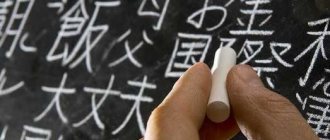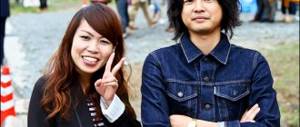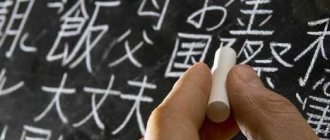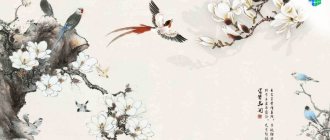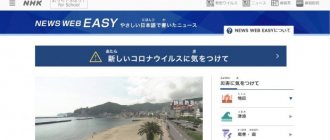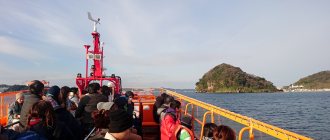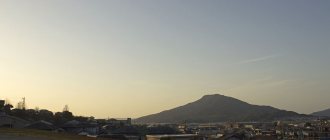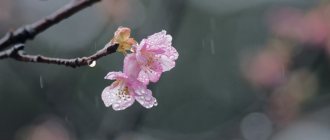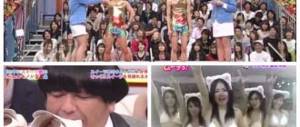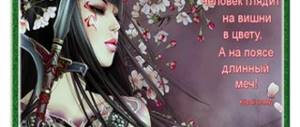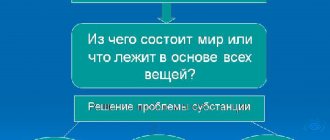Japanese poetry
...Without any effort she moves heaven and earth
Captivates even gods and demons invisible to our eyes
Refines the union of men and women
Softens the heart of stern warriors... This is the song.
Ki no Tsurayuki. From the preface to the collection “Kokinshu”
Probably, among all nations, songs and poems are born from one “source,” but only among the Japanese, a song does not necessarily imply music. “Song is not equal to poetry, but it is neither higher nor lower than it.” This is how the Japanese usually express themselves in multiple meanings.
Types of Japanese poetry:
- Tanka is a short lyrical song.
- Sadoka - six-verse.
- Renga is a chain of word images that disintegrates towards the end.
- Haiku is an independent genre that is still popular today.
- Uta is a five-line poem that serves as an appendix to Nagauta.
- Nagauta is a very long ballad.
- Haiku is traditional poetry of Japan.
- Cinquain - 5 unrhymed lines.
- Kyoka is a satirical genre of poetry (crazy poems).
- Rakushu - satirical poetry of the 13th-14th centuries.
One of the first evidence of the monumentality of poetry, which is now considered a “monument” of the poetic principle, is the anthology “Manyoshu”. The translation of this name is also ambiguous: “Collection of songs over many centuries” or “Collection of myriads of leaves.” This anthology dates back to the 8th century and is divided into 20 parts, which together contain 4,500 poems. This truly unique collection is made up of works spanning 4 centuries!
Manyoshu contains all types and forms of Japanese poetry. The most interesting, oddly enough, is social poetry. In itself, it was a rare occurrence in those days. And, of course, there are a lot of anonymous poems in this anthology. This is very significant because when similar anthologies were made in later times, poems whose authorship is unknown were not included.
The second evidence of the development of poetry was the collection “Kokinwakashu” of 26 scrolls and 1111 poems. In addition to the division into lyrical and landscape, there are presented: poetic complaints, congratulations, travel poems, acrostics.
This anthology was collected by imperial decree, who considered it his duty to take care of the heritage of poets of his own and other centuries. Interestingly, the preface in Chinese was written by Ki no Yoshimochi, a poet and great connoisseur of poetry, whom even the Japanese emperor recognized. So, this collection is the most successful and thorough attempt to tell the reader about the history of poetry in Japan. It was Kokinwakashu who established the rules for tank construction and made this form canonical.
Since the 12th century, renga has become popular in Japan - a poetic chain that breaks up into links towards the end. This form originated from tanrenga (short form of renga), which were composed by two different poets - the first three lines of 7 syllables were written by one poet, the last two lines by another. And then the form developed into terenga and kusari renga, which were already written by several poets.
In the Kamakura era, renga acquired its own canons, and its form was transformed. Now it was supposed to have a hundred lines, and such directions as soulless renga mushin and soulful renga ushin appeared.
The first is not lack of spirituality in the literal sense, but that form of verse that is filled with humor, sometimes obscene. Soulful ones are an elegant form of expressing serious concepts.
Towards the end of the era, Kamakura renga, as the most popular form, acquired exceptional masters. It was at that time that poets appeared who devoted their lives exclusively to this word form. Among the many masters was Nijo Yoshimoto, who was a student of the famous Gusai. Together they compiled a collection of renga, a kind of anthology and a set of canons according to which they were to be composed. To this were added the contributions of Shinkei and Takayama Sozei, who created a treatise in which they emphasized the importance of refined beauty (ushin, yugen).
And then a group of poets took up the form of wuxin renga verse, who set out to bring this poetry to perfection. Sogi led the group, and was joined by Socho, Inawashiro Kensai, and Shohaku. Although the goal seemed unattainable, these poets managed to achieve perfection of form, and this is recognized by everyone in Japan. However, after Soga's death, the decline of the wushin renga genre quickly set in.
But nothing dies just like that; this form was replaced by haiku, haikai and haiku. They were, as it were, transitional forms from mushin renga. These tercets absorbed humor and wit.
The haikai poetic direction was characterized by the haigong form - a colloquial style, borrowing words and Chinese words, phrases that were not previously allowed into the lexicon of poetic word form.
Of course, in how to write and what to use, there was a struggle over rules and canons. Matsunaga Teikotu promoted a formalistic approach. He wanted haikai to eventually become established as a noble, elegant form of courtly art. After the death of this poet, his rulebook was challenged by a unique school of poets under the leadership of Siyama Soin. He emphasized the comic aspects. The Yakazu Haikai movement arose at Shiyama's school. It was a practice of free association, based on which one had to come up with as many poems as possible alone.
In the 19th century, the art of haikai became so widespread that the number of writers grew into poor quality. Only Kobayashi Issa was able to break through this dam of second-rate poetry, who sang the love of insects and nature, small animals, and also wrote a lot about his poverty.
The 19th century was also marked by the emergence of a galaxy of romantic poets. They became real movers of the new style, who did not want to recognize traditions and stood up for European poetry. Changes came immediately in poetry; the era was called the Golden Age of Shintaishi. These incredible changes were marked by the appearance of Shimazaki Toson's collection. The lyrics of this poet reflected the era of social change. And just then Doi Bansui appeared, who proclaimed romanticism. Shimazaki and Doi were very different from each other. Doi published a collection where he talked about the problems of existence and the eternal question of finding one’s place in this universe. And Shimazaki expressed sincere, youthful joy in spring, nature, and love.
These are the colors in which Japanese poetry emerged at the threshold of the twentieth century. Needless to say, there were many more wonderful poets than listed. And the poetic “battles” of young writers with old ones are very interesting, especially if you read the poems themselves. But it is impossible to pay attention to everyone in one article. Therefore, moving to the present century, we would like to mention that in these years Japanese poets had already recognized Rimbaud, Verlaine, Mallarmé, Baudelaire and other European poets who became famous for the genre of symbolism. And this undoubtedly influenced what the Japanese brought to it with their understanding of things, nature and their view of the world.
And if classical poetry may be a little difficult for you, then modern poetry is within your power. But under no circumstances rely on translation; often 10 translations can be made for one poem - and not one will be completely accurate. To do this, it is better to read the text in the original. If you want to improve your Japanese knowledge or learn it from scratch, we invite you to our Japanese language courses!
Europeans and people of the New World greeted the tenth and twenties of the twentieth century, full of enthusiasm and confidence that in the very near future the world would be conquered. Jules Verne's novels already existed, technological progress replaced the old horse. New people joined art, young and active, who wanted not only to renounce the old, they wanted something radically new.
Innovation burst into Japanese poetry through the experimental poetic line of Kawaji Ryuko. He quickly found many like-minded people who abandoned symbolism, abandoned the old written bungo and brought a living colloquial genre into the world. Many naturalistic schools arose. Among the new poets, Fukushi Kojiro especially stood out, who composed poems about the true owner of the planet’s wealth - man. It was during these times that poetry became democratic, it spoke not only to the aristocratic elite and well-read people, but also to the common people. A “folk school” of poets emerged, from which real classics emerged, such as Ishikawa Takuboku.
If it seemed to you that socialist sentiments began to hover in the air of those times, so it is. The so-called “proletarian” literature and poetry in particular began to convey the truth about the difficult everyday life of ordinary people. And on this wave, poets who lived in exile rose to the top with their witty poems about the self-awareness of peasants and workers, and in the vanguard were poets with creativity that arose under the influence of “leftist” Western art.
Who stood in the opposite camp? Already at the end of the 20s of the twentieth century, on the basis of the magazine “Si to Siron”, an influential community emerged that advocated the ideals of surrealism and a clear distinction between politics and poetry. This movement was led by the famous Nishiwaki Junzaburo.
Japanese modernism has proletarian roots. Sounds a little ironic, but it's true. Poetry was filled with formalistic techniques that the unconventional new movement could neither use nor bring to Japan such an author as Miyazawa Kenji.
Of course, there were some radically minded young people who wanted a place in the sun for a “stream of consciousness” without edits and restrictions and for the so-called “automatic writing.” The best of these poets are Ono Tozaburo, Murano Shiro and others. During their lifetime, they were recognized as masters of modernism, skillfully using technology without breaking away from real life.
Late 30s. Japan was illuminated by a new phenomenon - the magazine "Siki", which gave rise to "unbiased lyrics". On the other hand, currents from the Rekitei association poured into the poetic world, which declared themselves anarchists. This community was headed by Nakahara Chuya, and he promoted the combination of Buddhist abstraction of the philosophical school and the aesthetics of nonsense. These two streams of poetry bubbled and excited minds for a very long time, but the Second World War was ahead.
Japan as a state was expected to collapse. The national ideals and moral values of the people that led to the tragic events that we all know about were rejected.
New poets sought to comprehend the essence of Evil and find that Good that could be opposed to the forces of destruction. The accusers of the past were Kaneko Mitsuharu. Front-line poetry by Ayukawa Nobuo and other famous poets appeared, telling about the horror of war. The “Left Movement” actively promoted “democratic poetry.” They began to lose their position, but were still popular among, so to speak, “dissenters.”
At the end of the 50s, the Areti association published poetry full of disappointment. In general, poetic circles turned their attention to negation and search. And in all this one could see a search not even for a new form, but for old values.
Traditional humanistic values were now rediscovered in lyrics about friendship, love, and mercy. Tanikawa Shuntaro was truly one of the best poets of that time, who managed to show not only the Japanese, but also world art the aesthetics of new poetry. And what was yet to be discovered was the neo-avant-garde, the anarchy of poetic rebellion, the nonconformist direction and the nihilistic movement, which no longer rebelled against the foundations of Japan, but against the foundations of the world.
Which famous Japanese poems resonate with you the most? Do you like Japanese poetry? If yes, what period? Tell us in the comments.
Of course, to understand the Japanese philosophy embedded in poetry, you need to work hard, but you can learn to read Japanese in just a week! Don't believe me? Follow the link and get the video course “How to learn hiragana in a week”!
We recommend:
Ancient literature
Initially, myths and songs were common in Japan, which were transmitted orally. However, closer to the 7th century, everything changed. Emperor Tenji established higher schools where Chinese was taught. Soon, the written Japanese language emerged by borrowing and optimizing characters from China. Thus, by the 7th century, writing began to actively spread. As a result, monuments of Japanese literature began to appear.
The first Japanese work that has survived to this day is a chronicle called Kojiki. It was written by Yasumaro Ono in 712. The book contained various folklore, represented by songs, myths, fairy tales, legends, etc. In addition, the work also had historical value. Indeed, in the Kojiki the author left some historical legends and chronicles.
Another example of ancient Japanese literature is Manyoshu. The book was a huge collection of lyrics, which included more than 4,000 folk and original tanka poems.
Classic literature
The next stage of Japanese literature was called classical. It lasted from the 8th to the 12th centuries. What is characteristic of this period? Japanese literature was strongly intertwined with Chinese. Most of the Japanese people were illiterate. It was for this reason that Japanese fiction spread among the aristocracy and high court circles. Perhaps the main feature of this era is that most of the works were written by women. It is for this reason that family and other decent motives predominate in classical Japanese literature.
The most striking example of literature of this era is “The Tale of the Beautiful Otikubo.” The book tells about the life of a Japanese Cinderella, who huddled in a tiny closet, while honoring the customs of her ancestors and moral precepts. Thanks to her high morality, the girl was able to rise from rags to riches, because a noble and rich gentleman fell in love with her.
If we talk about genre orientation, literature has moved away from folk art. Myths and fairy tales were replaced by higher genres: short stories, tales, short stories, etc. In the 10th century, the first Japanese novel was even published called “The Tale of Old Man Taketori.” It tells the story of an old woodcutter who meets a little girl who turns out to be an inhabitant of the Moon.
Medieval literature
This literary period lasted from the 12th to the 17th centuries. The power in the country has changed dramatically. The Mikado, who were the country's highly intellectual elite, were replaced by a military class called the shogun.
The country's literary activity began to decline rapidly. Genres such as the novel and Japanese poetry fell into oblivion. Memoirs of outstanding commanders and works of a historical nature were extremely popular. In general, Japanese literature became more violent and bloody. It is also worth noting that women writers did not take part at all in the medieval literary process of Japan.
"Genpei Josuiki" is a prominent representative of medieval Japanese literature. The work tells the story of the rise and fall of two families of aristocratic origin - Genji and Heike. The book is reminiscent of a Shakespearean chronicle in spirit. The work is characterized by brutal heroic battles, the interweaving of historical truth with fiction, the author's digressions and reasoning.

